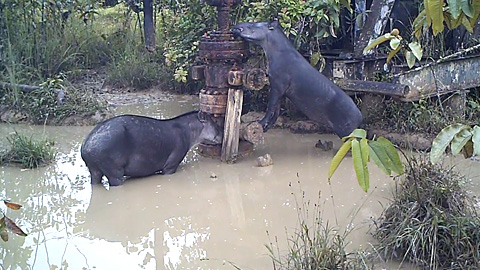Amazon's indigenous people eat animals feeding in areas contaminated by oil spills

05/03/2018
The wild animals hunted by the indigenous people of the Amazon rainforest drink water and eat soil which is contaminated by the oil extraction industry, according to a research by the Institute for Environmental Science and Technology of the Universitat Autònoma de Barcelona (ICTA-UAB), the UAB Department of Animal Health and Anatomy, the Institute of Global Health of Barcelona (ISGlobal), and the International Institute of Social Studies (ISS-EUR). The research, which for the first time reveals images of how the animals drink water and eat soil (geophagy) contaminated by oil spills or directly by the oil wells, alerts of the risk this represents for the health of the populations hunting these animals for food.
The research, published in Environmental Research, forms part of a broader scientific project developed by the ICTA-UAB and led by Dr Martí Orta-Martínez for more than a decade now, dedicated to analysing the alarming levels of oil contamination existing in remote areas of the Peruvian Amazon near the border with Ecuador. In previous studies, scientists demonstrated how oil extraction activities conducted in the past four decades have in general contaminated the soil and headwaters of the rivers not only through accidental spills, but also to a large extent by the discharge of produced waters extracted together with the oil.
These produced waters contain high concentrations of salts and heavy metals such as lead, cadmium, chromium, barium and hydrocarbons. The contamination, which affects rivers, sediments and soil, spreads throughout 3,000 kilometres of the Amazon river and is bioaccumulative, putting at risk the health of fish, animals and the people who eat these animals.
The installation of camera traps allowed the recording of images of mainly four wildlife species (tapirs, pacas, peccaries and red deer), the most important species in the diet of the region's indigenous communities, representing between 47% and 67% of their total meat consumption. These mammals, residents of an ecosystem poor in salt as is the Amazon, commonly supplement their diets with surface minerals by eating the soil. However, they have now been seen near the oil extraction sites, attracted by the high salinity of the produced water. The same behaviour was also observed among endangered species.
The discovery could be related to the high levels of lead and cadmium detected in the blood of 45,000 inhabitants of five indigenous ethnic groups of the region. According to Peru's Ministry for Health, 98.6% and 66.2% of the area's indigenous children surpassed all acceptable limits of cadmium and lead in blood, as did 99.2% and 79.2% of adults.
This region of the Amazon rainforest was declared an environmental emergency by the Peruvian government in 2013 and a sanitary emergency in 2014, but no local registries of morbidity or mortality exist up to date. Nevertheless, scientists remind authorities that "these compounds are neurotoxic and cancerigenous".
Citizen Participation Project
As part of the study, the ICTA-UAB and the UAB Department of Animal Health and Anatomy launched a citizen participation project based on collaborative recognition which aims to identify other possible species appearing in the more than 8,000 camera trap recordings taken in the region of Loreto, Peru, during approximately 500 days.
Through the creation of an interactive online platform in English and Spanish scientists aim to identify all of the Amazon species seen consuming petrolium-contaminated water and soil, as well as analyse their behaviour.
The “AmazonOil” platform, launched thanks to funding by the BBVA Foundation, includes the support of the region's indigenous associations FEDIQUEP, FECONACOR, OPIKAFPE and ACODECOSPAT. The final version of the citizen science platform will be available starting on 28 March at https://www.zooniverse.org/projects/marcartro/amazonoil.
Original article:
Orta-Martínez M., Rosell-Melé A., Cartró-Sabaté M., O’Callaghan-Gordo C., Moraleda-Cibrián N., Mayor P. First evidences of Amazonian wildlife feeding on petroleum-contaminated soils: A new exposure route to petrogenic compounds? Environmental Research. 2017, https://doi.org/10.1016/j.envres.2017.10.009